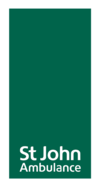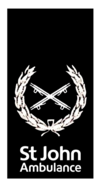Ranks and insignia of St John Ambulance (England)
This article has multiple issues. Please help improve it or discuss these issues on the talk page. (Learn how and when to remove these template messages)
|
From its beginnings, St John Ambulance employed ranks and insignia to distinguish grades within its membership and management structure; these were extended across the wider organisation following its merge with the St John Ambulance Association to form St John Ambulance. Based upon the British Army officer and the British Army other ranks structure and insignia, the original ranks and insignia have been subject to several modifications over the history of the organisation.
The basic "star" or "pip" has at its centre the eight-point Maltese Cross, the badge of the Order of St John. The crown used is also that of the Order. At the higher general list ranks, crossed stretchers are used rather than the crossed sword and baton of military use. Insignia are in silver, again symbolic of the Order of St. John.
Also, officers who hold rank within the organisation at or above R4 wear a cockade in their hat (women) and have a silver bar (men), however at or above R3 wear a cockade and tuft (women) and silver bar and Wort cap (men).
Since the mid-1990s, the former "Senior NCO" and "Warrant Officer" ranks have been abolished. These ranks, whose titles were "Staff Sergeant", "Corps Sergeant Major", and "County (or District or Bailiwick) Sergeant Major" were deemed too militaristic in form, although a few previous incumbents remain. Their demise has gone hand in hand with a lowering of emphasis on parading and drill. The county Sergeant Major, if the county has appointed one, wears member rank slides and Warrant Officer Class 2 (St John Crown in laurel leaves) arm badges on the bottom of each arm.
Nurses used to wear Rhodium Metal bars on their Shoulder Straps. A red enamelled bar denoted a State Registered Nurse (SRN). A purple enamelled bar denoted a State Certified Midwife (SCM) and/or a Nurse on the Special Part of the State Register, i.e. psychiatric or learning disability. A green enamelled bar denoted a State Enrolled Nurse (SEN). Their use was abandoned in the mid-1990s.
In 2012, one Warrant Officer Class 1 (wearing Royal Arms badges in silver on both arms) was appointed at National HQ to advise on ceremonial matters across St John Ambulance.
In December 2013, as a result of the rank review, a simplified rank structure was introduced, being fully implemented by the end of March 2014. The aim of the new rank structure is to ensure that rank is applied consistently throughout the organisation and that it is applied only based on an individual's role. A number of ranks will cease to exist as a result of this change, and the requirements for many of the remaining ranks will change.[1][2]
In December 2016, it was announced that effective 1 January 2017, no rank is to be worn on events, except by persons who are performing an operational management role at that event. Persons who are undertaking an operational management role, but who do not have rank, will continue to not wear rank. Persons who do have rank, but who are not in an operational management role at the event, should not display their rank.
In August 2023 it was announced that all rank would cease to be worn on events from that month. It will continue to be displayed during ceremonial events.
National variations[edit]
Whilst this article uses English St John Ambulance practice as standard, inevitably national variations in rank structure have occurred as the organisation has spread to other countries, and subsequently developed in those countries with a degree of autonomy. The English types are presented in the illustrative tables below. Ranks in other countries are usually similar, but adopt local terminology, such as (for example) "Provincial Commissioner" instead of "County Commissioner". There may also be fewer ranks in smaller countries, as a result of the need for fewer rungs of management structure.
Unique Rank Slide Specifications[edit]
In 2013, St John Ambulance UK rolled out a new design of rank slide. While the insignia, colours and text font remain unchanged, the slides themselves are now much longer and wider, with the insignia being much larger. This updated design for rank slides corresponds with the rise of the Service Delivery Uniform (SDU), rolled out in 2011. This is the first modification to the design of the rank slides since the change from cloth and thread to rubber-made rank slides, with a new font for 'St John Ambulance' title on all slides.
This was later abandoned.
Role-Based Variations[edit]
In a similar fashion to the Police, St John Ambulance used to have a number of role-based variations on the standard rank markings detailed below. For large-scale events where a Gold, Silver, Bronze command structure is used, the Silver and Bronze commanders used to wear white and orange rank slides respectively. This is no longer the case.
Rank tables[edit]
Operational Rank and Insignia[edit]
| Colour | Red | Grey | Green | Blue (Wales only) | Black |
| Insignia (rank slide) |
 |
 |
 |
 |

|
| Meaning | Registered medical practitioners |
Registered nurses and midwives | Registered paramedics | Registered technicians | Personnel without Healthcare Professional registrations |
Management Rank and Insignia[edit]
| Rank | R2 | R3 | R4 | R5 | R6 | R7 |
| Insignia | 
|

|

|

|

|

|
| Role | Regional Management Team (including District and Department Managers) |
Uniformed Regional Management Team direct report (Including Area Manager) |
Uniformed Regional Management Team indirect report (excluding Unit Manager) |
Unit Manager | Uniformed unit management team | Uniformed Front line Personnel (including young people in SDU) |
| Replaces | County Commander | Assistant Commissioner or County Staff Officer |
Area Officer or County Staff Officer |
Divisional Superintendent | Divisional Officer or Medical/Nursing/Ambulance Officer |
Brigade Member |
| Accountable to | Regional Commissioner | District Manager | Functional RMT Manager | Area Manager | Unit Manager | Unit Manager |
| Rank | R0 | R1 | R2 |
| Insignia | 
|

|

|
| Role | Chief Commissioner | National Advisers reporting to the SMT and Principal Priory Officers |
National Advisers not reporting to the SMT |
| Replaces | Chief Commander | Deputy Chief Commander | County Commander |
- Note: At the end of 2012, the Counties of England merged into eight accountable "Regions", sub-divided into geographic "Districts"; each Unit (previously "Division") was grouped together with nearby Units to form numbered "Areas" within each District, under the oversight of an "Area Manager". Before this, "County" was the basic administrative unit for command purposes (in London the title "District" was used instead). For each of the Channel Islands of Jersey and Guernsey the title "Bailiwick" is used.
Unit Leadership Roles for Young People[edit]
| UK cadets |
Officers | Cadet senior NCOs | Cadet junior NCOs | Cadets | Recruits | |||||||
|---|---|---|---|---|---|---|---|---|---|---|---|---|
| CDT 8 | CDT 7 | CDT 6 | CDT 5 | CDT 4 | CDT 3 | CDT 2 | CDT 1 | CDT (R) | ||||
St John Ambulance Cadets ranks and shoulder marks
|

|

|

|

|
No insignia | |||||||
| No equivalent | Leading Cadet | No equivalent | Cadet Sergeant | No equivalent | Cadet Corporal | No equivalent | Cadet | Recruit | ||||
| LCdt | CdtS | CdtC | Cdt | Rct | ||||||||
- Note: Non-Commissioned Officer ranks, prior to the Rank and Role review 2013, were available to adult volunteers. Post the 2013 changes, NCO ranks are not applied to adult volunteers.
Rank review 2013[edit]
In December 2013 St John Ambulance officially announced its conclusion of the rank review that it had undertaken, subsequently issuing advisory documents to its members with detailed explanations.
The review was developed to ensure that consistent and appropriate use of rank for positions, from the Unit up to the senior volunteers at National Headquarters. All existing ranks were removed and the new structure applied.
Commissioned Officer ranks[edit]
The original Commissioned Officer ranks modelled on the British Army rank structure was largely replaced with insignia similar to the Metropolitan Police. A large number of ranks were removed and the structure simplified.
Non-Commission Officer (NCO) ranks[edit]
As a result of this rank review, it was decided to remove all NCO ranks for adult volunteers and staff across the organisation. A Sergeant Major at National Headquarters continues to be appointed to advise on matters relating to ceremonial events.
Whilst these ranks have been removed for adult volunteers and staff, they still remain in place for Cadets.
Assistants and deputies[edit]
As a result of this review, Assistants and Deputies are no longer permitted through St John Ambulance, however additional team members may be added for geographical coverage.
Role Bars[edit]
With the introduction of the green Service Delivery Uniform (replacing the traditional No. 2 Service Uniform), black removable Role Bars that could be fixed to the uniform were introduced that would denote the volunteer's role during operational work. Leadership positions on the frontline were no longer indicated by the volunteer's rank insignia, but by the role bar worn on the uniform.
Role Bars such as Operational Commander, Treatment Centre Manager, Team Leader etc. are provided to volunteer leaders during operations to indicate their operational role. If an Officer is deployed on the frontline and is not acting in a leadership position, they are required to wear the Uniformed Frontline Personnel (Formerly "Brigade Member") insignia to prevent confusion.
Rank Review 2023[edit]
In June 2021, St John Ambulance embarked on another review of the service's rank structure. The question of whether is it still appropriate to wear rank insignia on a uniform to denote the leadership and management role, responsibility and accountability in 2021 and beyond was put towards members of the service. Certain ranks, such the rank of Chief Volunteer introduced in 2013 had already been changed to Chief Commissioner prior to reviews commencement.
The review was put on hold during the COVID-19 Pandemic and was eventually restarted in 2022 with a former Chief Constable appointed as Chair. In May 2023, the conclusion of the Rank Review was officially announced concluding that Officers would continue to wear insignia to denote their position within the service. However, insignia was no longer to be worn by any volunteer deployed on the frontline including those in management positions.
Aug 2023 The first of the review’s recommendations[3] regarding operational activity and are removing rank from all patient-facing activity, including in leadership roles. As of Thursday 24 August 2023, rank markings will no longer be worn in all ambulance, community, event and EPRR operations. This will include Cadets.
People undertaking a leadership role, for example at an event, will be identified by the wearing of the appropriate role bar – for example: ‘Event Manager’, Treatment Centre Manager’ or ‘Event Clinical Lead’.
The role bar to be worn by the event leadership team will be identified in the event operational plan. Regardless of role the only epaulets authorised for our patient-facing activities will be plain-coloured epaulets relevant to the clinical grade of the individual who wears them.
References[edit]
- ^ Messinger, M. and Killen, S. (2013) 'Announcement about the conclusion of the rank review', [ELECTRONIC], accessed 17 Dec 2014.
- ^ St. John Ambulance, People and Organisation (2013) 'Rank structure: Quick reference guide', [ELECTRONIC], accessed 5 Jan 2014.
- ^ https://stjohn.sharepoint.com/sites/c-news/SitePages/Rank-markings-for-operational-activity---changes-as-of-24-August-2023.aspx
